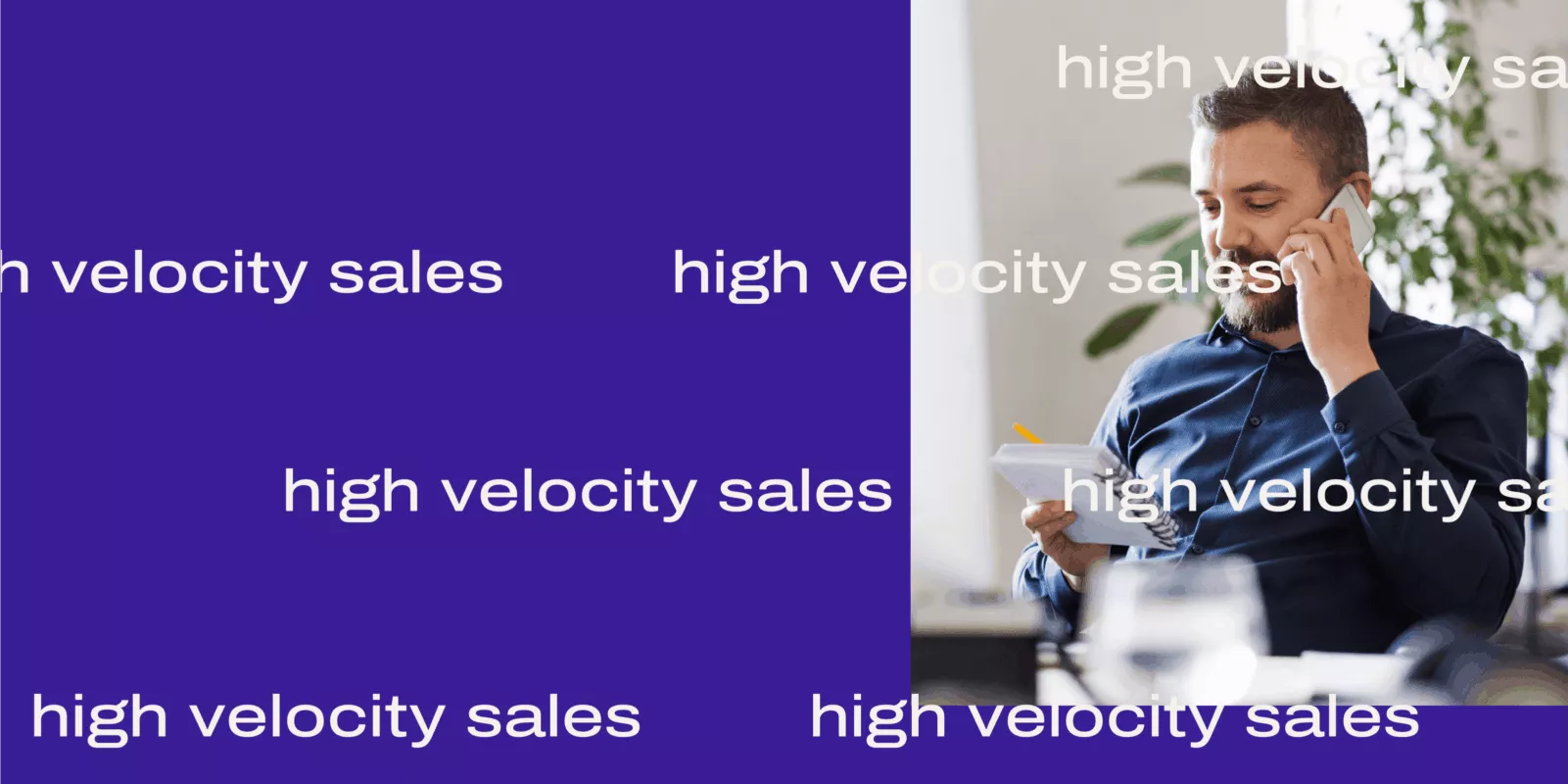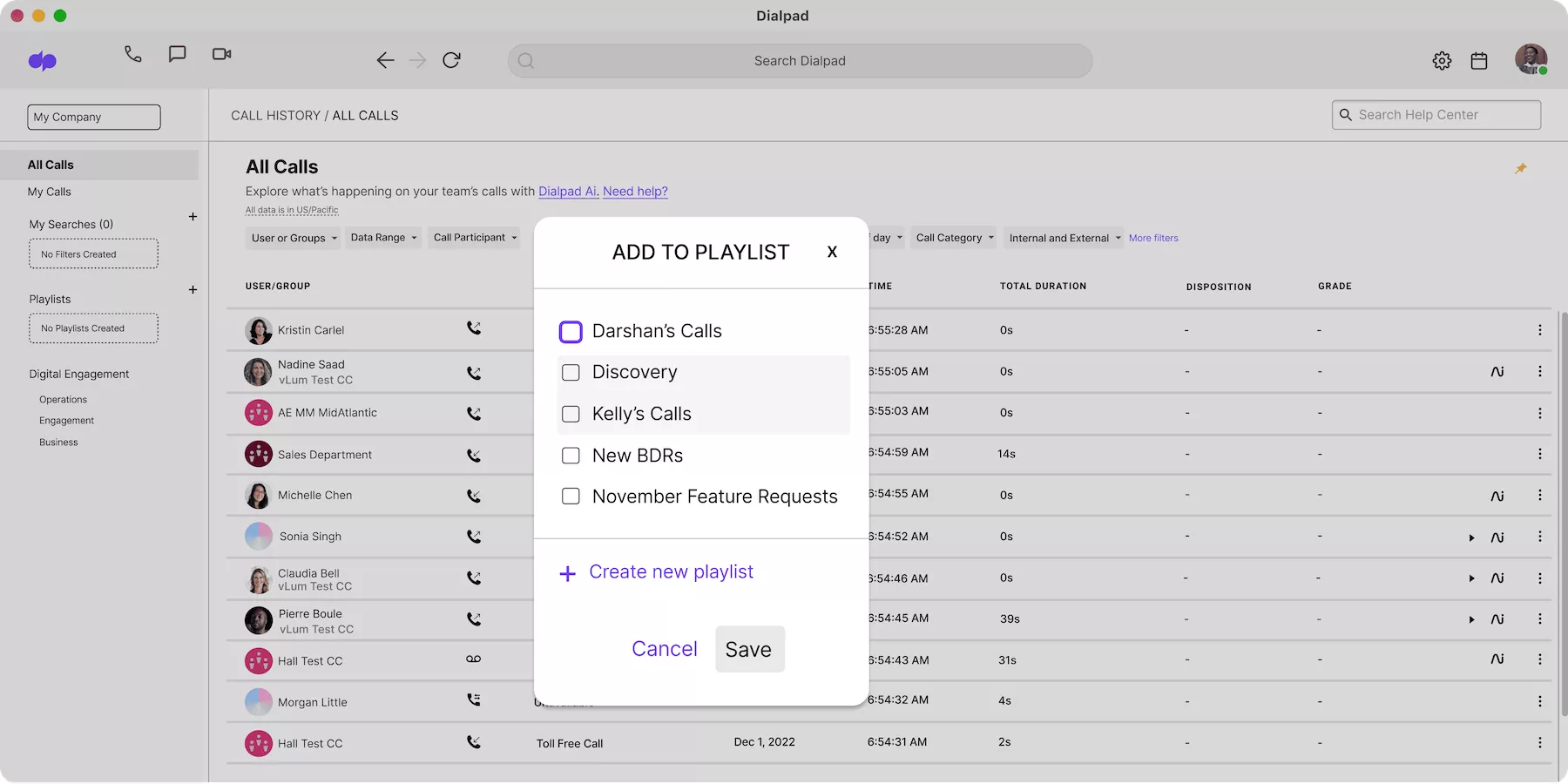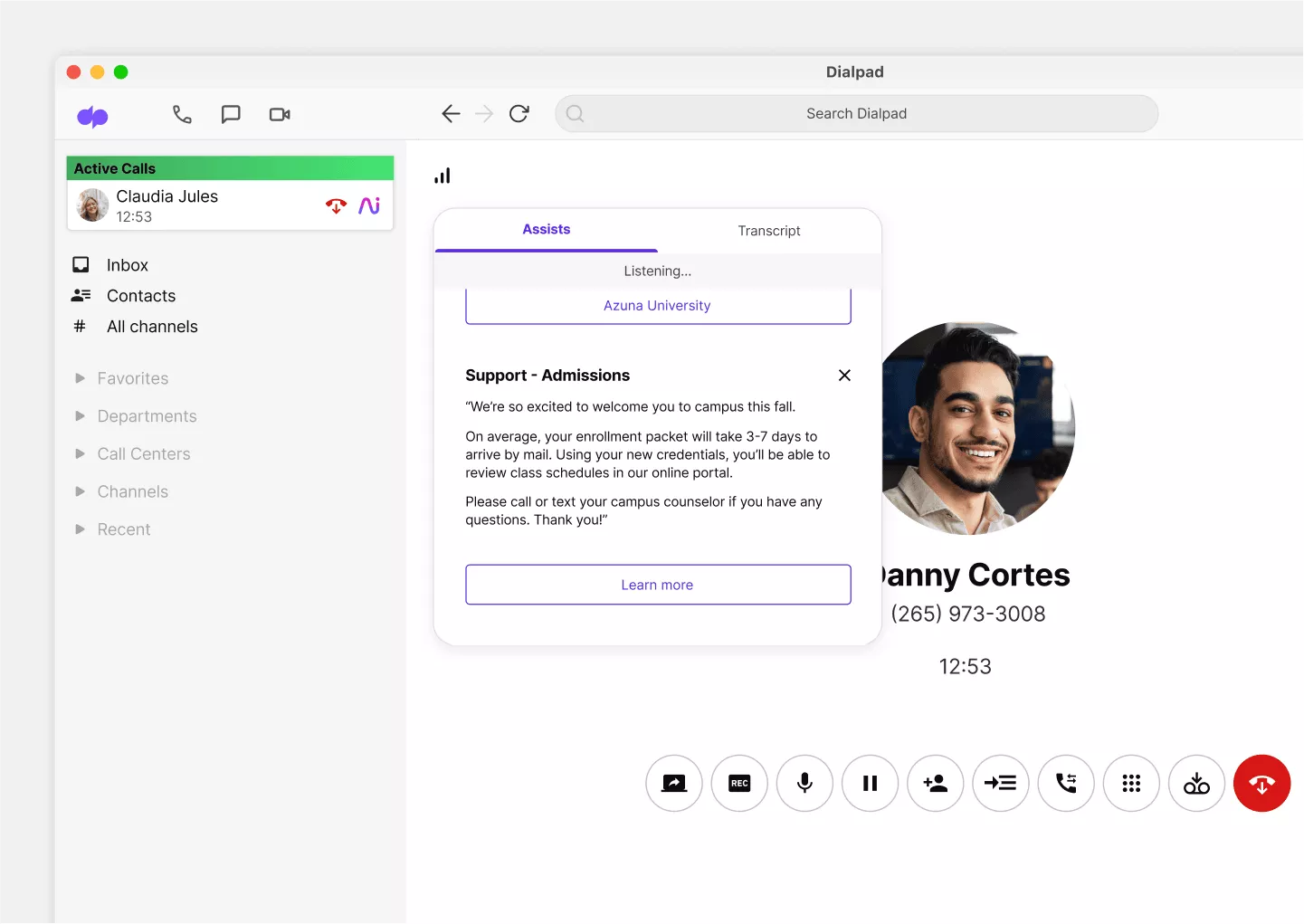How to define and refine your high velocity sales strategy

Cold, hard truth: Most leads don’t convert to customers. Bummer, right? But if you’re part of the 56% of companies dissatisfied with their conversion rate, you’ll be happy to know there’s a way to improve that number.
The strategy involves implementing a high-velocity sales process that's designed to help your sales team get as many opportunities as possible to connect with prospects.
In this guide, I'll walk you through what high velocity sales is, a few tips learned from our own sales tactics and experiences, and more.
What is high velocity sales, exactly?
High velocity sales (HVS) is a term commonly used in SaaS sales. As the name suggests, it’s designed to ramp up the sales process for better productivity.
HVS integrates B2C sales techniques and applies them to the B2B sales process. It’s favored by inside sales teams, typically involving automation and artificial intelligence to streamline workflows for maximum efficiency.
Using Dialpad and Salesforce for high velocity sales
Sales reps often use Salesforce as a tool to help with high velocity sales, as well as sales communications platforms like Dialpad. But alongside these sales apps, you also need to have a few strategies for how to make HVS work.
For example, Dialpad’s integration with Salesforce has a power dialer that’s designed to help reps make more outbound calls in less time:

Salesforce High Velocity Sales also features a Work Queue, with prioritized lists of emails, calls, and tasks defined by the sales cadence. It integrates with Dialpad to save you even more time by auto-logging calls, activities, and notes right to the CRM. And it even pops up Dialpad's AI-powered Real-Time Assist cards automatically—inside Salesforce—to help reps answer tricky questions in real time:

(Besides Salesforce, Dialpad also integrates with other CRMs like Kustomer, Zoho CRM, and HubSpot.)
Plus, the Salesforce integration gives you the Lightning Dialer and Lightning Sales Console. Check out how Randstad's global recruiting team uses Dialpad's Salesforce integration to reach more candidates more quickly, and how alcohol marketplace Drizly used Dialpad + Salesforce to improve how they track performance and conversions.
4 best practices for high velocity sales—and a few considerations for each
1. Get your team as many at-bats as you can
A key part of HVS is to accelerate the generation of new leads. That means a hyper-focus on efficiency—you have to give your sales reps as much time as possible to reach out to and connect with prospects.
For many businesses, outbound phone calls are the main way to connect with prospects. If that’s the case, you need a power dialer or some kind of dialer tool that automates the calling process so that reps don’t have to manually dial a phone number every time.
An opportunity to help reps save time if they’re on the phones a lot: give them a tool with a voicemail drop feature.
This is a feature that essentially lets sales reps record a voicemail message and “drop” it into a phone call when they hit a prospect’s voicemail. This way, they don’t have to spend time reciting the same message every single time. Again, this is a feature that you’ll find in Dialpad:

Email integration is another key step in your sales process to optimize. Your sales team is likely using email heavily—can you integrate it with their other tools like their communication platform, to automate things like generating meeting links?
That’s a really underrated feature to have, and even though it seems like just a few seconds, those seconds add up. Dialpad integrates with both Google Calendar and Outlook Calendar to automatically generate meeting links in meeting invites so that prospects can just click the link to join the call:

2. Have a long-term plan for nurturing leads
How long is “long-term?” Well, it depends on your sales cycle and industry, but generally it does take time—anywhere from days to weeks to even months or years if you have a high ACV (average contract value) product—to nurture leads. With high velocity sales, you can’t forget about lead nurturing, which means giving special attention to your prospects.
Have a multi-channel nurturing strategy
Prospects may appear from any channel, so make sure you’re ready to interact via email marketing, web content, and direct outreach. That’s a lot of balls to juggle, so it helps if your sales and marketing teams are aligned.
You can’t expect prospects to convert instantly, so deliver content that helps them through the buyer journey. Use a mix of content like blogs, videos, and whitepapers—and don’t forget social media channels like Instagram and LinkedIn.
Use targeted content
Personalization is another lead-nurturing tactic. You might use buyer personas (more on them later) as a starting point, creating targeted content based on characteristics such as interests and objectives.
You can also look at intent data (which you would get from a marketing automation platform) to understand what prospects are looking for—and it pays to research people and companies so you can target them with industry-specific content.
Be diligent with following up on leads
The odds of conversion are higher if you make contact quickly, so have a robust process (and SLAs) in place to ensure fast responses.
If you take webinar registrations, follow up with folks who don’t attend as well as those who do. When a whitepaper is downloaded, ask if the person needs any additional info.
And if somebody requests a demo or quote, your inside sales team has to be responsive—ideally within a few minutes of them requesting it. This is one of the most obvious signals for sales engagement, and you should strike while the iron is hot.
Implement lead nurturing
For successful lead nurturing, reps must maintain interest throughout the buyer journey. It’s about developing and reinforcing relationships, and building trust in your business.
You can use automation to send relevant information to prospects. This gives salespeople more time to focus on phone calls or personalized emails—or even connect with leads via video chat.
As with all strategies, take time to evaluate whether it’s having the desired effect. If someone in your team is especially good at moving prospects forward in the sales journey, record their sales calls and share them with everyone. (Learn more about how to plan sales calls.)
In Dialpad, you can create a playlist of recordings that sales reps can listen and learn on their own time:

3. Create an airtight inside sales strategy
As we mentioned earlier, inside sales reps work remotely or in a company office, instead of going “outside” to meet prospects in person. They'll typically use technology (like Dialpad's sales engagement platform, Salesforce, or Sales Cloud) to connect with each other and with prospects.
Have a thorough understanding of your product or service
If you don’t understand what the product does, how can you explain it to someone else? Training is vital to ensure sales teams can confidently demonstrate products and services.
Reps have to be ready with answers to common questions from prospects about things like pricing and what makes you better than competitors—but what if you don't want them to memorize call scripts and sound like robots? (Or what if they don't have time?)
With Dialpad, we can create Real-time Assist (RTA) cards, which are kind of like sales battle cards that automatically pop up on a rep's screen when certain keywords or phrases are spoken on the call:

Say we have a "Competitor X", who always gets mentioned by prospects on sales calls. A sales manager can create an RTA card with notes about how to position ourselves against Competitor X, and set it to trigger automatically whenever their name comes up in a call.
(This is thanks to the magic of Dialpad's built-in artificial intelligence, Dialpad Ai, which can transcribe phone calls being made through Dialpad—in real time.)
Use templates to streamline sales processes
Typing out the same thing multiple times is a waste of time. With email templates, you can create a general outline to ensure consistency, and easily paste in pre-written business or product information.
Automated emails can also be sent when visitors complete a specific action. Triggered emails have a 38.03% open rate, compared with 18.76% for a newsletter. (It’s usually worth including some personalization in emails, even if it’s just the name.)
Besides email templates, templates can work for your sales playbooks too.
With Dialpad's Ai Playbooks feature, for instance, coaches and supervisors can track rep adherence to sales methodologies like BANT, SPIN, and SPICED more easily. Dialpad Ai can automatically suggest questions and phrases that they need to say during a call (for example, asking about budget or purchase timelines), understand whether the behavior was met, and check the task off the list (or notify managers if this isn't being done):

This is helpful for sales leaders, because they don't have to painstakingly review every single call, and can quickly tell which reps need additional coaching or if any parts of the methodology can be improved upon—all thanks to this sales AI feature.
Use a CRM
CRMs are almost a must-have in HVS sales strategies, because they help reps to manage and monitor the sales process and gain a deeper understanding of prospect relationships. You can easily track activities, record information, follow up, and see what to do next.
4. Establish the important metrics in your sales process
Every sales activity is measurable, and advanced tech means there’s plenty of data available—you just need to keep on top of it (it’s easier with tools like Dialpad’s post-call analytics).
There’s a range of metrics you can use to evaluate sales performance, such as quota attainment—this shows the percentage of reps reaching their targets and how that connects to overall revenue. Dialpad has a rep leaderboard with specific call metrics like placed vs received.
It’s essential to measure recurring revenue annually or monthly, as well as average revenue from specific products or accounts. And it’s worth comparing revenue between new and existing customers, to reveal where you should concentrate your efforts.
These metrics relate to Total Contract Value (total value of a contract, including fees and recurring revenue, for the contract period) and Customer Lifetime Value (average revenue generated throughout someone’s lifespan as a customer).
Sales activity
Sales activity metrics are faster to evaluate and easier to adjust than sales metrics. They highlight strengths and weaknesses in reps’ performance, and help determine which activities have the biggest impact.
Sales activities include calls, emails, social media engagement, proposals, and quotes, plus virtual meetings and sales demos. Basically, it measures how salespeople spend their time, and how much work is involved in winning a deal.
👉 Dialpad tip:
Dialpad helps you track call volume (and customer sentiment), which you can use to identify reps who need assistance—and there are sales coaching tools, too!
Pipeline metrics
These metrics reveal the effectiveness of your sales process. You can measure open opportunities (qualified leads in the pipeline), closed opportunities (both won and lost), pipeline conversion rate, and total pipeline value.
Pipeline metrics also measure the speed of the sales cycle, or how long it takes for someone to go from prospect to buying customer. Marketing and sales platform JumpCrew was able to reduce this by 50% with Dialpad, helped by live coaching and real-time data insights.
Lead generation metrics
You can evaluate and improve your lead generation strategy with metrics such as:
Click-through rate (efficacy of CTAs)
Percentage of follow-ups in a given time frame
Engagement rate (call results, responses to content)
Conversion rate
Costs (customer acquisition cost, ROI)
Consider using lead scoring to rank prospects by their value to your business—then you’ll know which to prioritize. You can do this with any Madkudu alternatives like Salesforce, where Einstein Lead Scoring analyzes past conversions to build a scoring model for each lead segment.
Productivity metrics
Sales productivity metrics measure which inputs (tasks carried out by reps) drive the most output (conversions and revenue), and how efficiency might be improved.
You might measure calls per day, meetings set per week, and percentage of time spent on data entry. Salesforce’s Einstein Activity Capture connects reps’ emails and calendars to the CRM, so it’s easier to track activity.
It’s also a chance to evaluate how well your tech stack performs. If productivity needs a boost, introduce CTI tools like power dialers and smart call routing. Dialpad’s heat maps and user-friendly dashboards help you measure things like average time to answer.
Ramp up your selling with a high velocity sales strategy
If you combine these practices, your team will be able to speed up the sales process, provide swift responses to prospects, and close more deals, more quickly.
Tools like Salesforce and Dialpad can help reps streamline workflows and increase productivity, and with Dialpad, you also get the benefits of HD audio, super-fast deployment, and an all-in-one workspace for seamless communication and functionality.
If you need a better way to communicate with prospects, give it a try!

